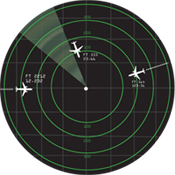|  In today’s world, the vast majority of all air traffic monitoring is carried out by ground based Secondary Surveillance Radars (sometimes called Secondary Radars, or SSRs) and aircraft based radar transponders. SSRs use a continuously rotating antenna that “sweeps” the surrounding airspace with a narrow beam that transmits “interrogation” signals. When the beam sweeps past an aircraft, its transponder sends back a coded “reply,” which contains the aircraft’s identification, altitude and, depending on the transponder type, additional coded information. In today’s world, the vast majority of all air traffic monitoring is carried out by ground based Secondary Surveillance Radars (sometimes called Secondary Radars, or SSRs) and aircraft based radar transponders. SSRs use a continuously rotating antenna that “sweeps” the surrounding airspace with a narrow beam that transmits “interrogation” signals. When the beam sweeps past an aircraft, its transponder sends back a coded “reply,” which contains the aircraft’s identification, altitude and, depending on the transponder type, additional coded information. By knowing the direction of the radar’s antenna when it sweeps past an aircraft, and by measuring the time between the radar’s interrogation signal going out and the aircraft transponder’s reply being received, the radar’s computer establishes the aircraft’s direction and distance from the radar. This information, plus the individual aircraft’s reply data, is sent to the air traffic controller’s display screen, where it appears as a “target,” with an accompanying identification “tag” with its individual data. As the SSR antenna continues rotating, once every 4 – 12 seconds, each aircraft will continue to be interrogated and will reply on each consecutive sweep, allowing their targets to progressively move across the controller’s screen in small “jumps.” The screen also displays the local airways and terminal areas, thereby allowing the controller to ensure that all aircraft are keeping to their assigned routes, altitude and speeds. SSR has seen many refinements over the past 50 years, since its development for civil use from military technology. However, the technology remains just that, technology developed during World War II. Many feel that its further development is limited, and its inherently high acquisition, installation and maintenance costs are substantial. There are also severe coverage and capacity limitations resulting from line of site issues due to terrain obstacles, such as mountains and buildings. | | 
SSR antennas rotate once every 4-12 seconds, receiving replies from aircraft with Mode A, C and S transponders.
"Traditional radar technology will not be able to fully support very advanced ATM concept implementations.” Heribert Lafferton and Dr. Roland Mallwitz, Surveillance Transition Scenario for German Airspace, DFS Deutsche Flugsicherung GmbH
|

